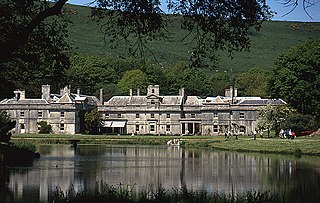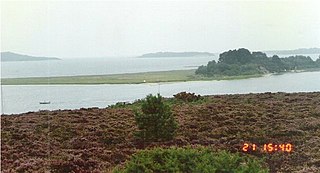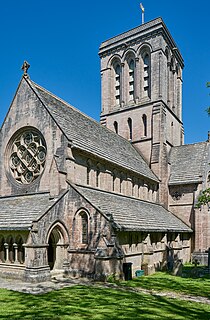 W
WCorfe Castle is a fortification standing above the village of the same name on the Isle of Purbeck peninsula in the English county of Dorset. Built by William the Conqueror, the castle dates to the 11th century and commands a gap in the Purbeck Hills on the route between Wareham and Swanage. The first phase was one of the earliest castles in England to be built at least partly using stone when the majority were built with earth and timber. Corfe Castle underwent major structural changes in the 12th and 13th centuries.
 W
WCorfe Castle is a village and civil parish in the English county of Dorset. It is the site of a ruined castle of the same name. The village and castle stand over a gap in the Purbeck Hills on the route between Wareham and Swanage. The village lies in the gap below the castle and is around four miles (6.4 km) south-east of Wareham, and four miles (6.4 km) north-northwest of Swanage. Both the main A351 road from Lytchett Minster to Swanage and the Swanage Railway thread their way through the gap and the village.
 W
WBrenscombe Heath is a 34.7 hectare biological Site of Special Scientific Interest in Dorset, notified in 1985.
 W
WChapman's Pool is a small cove to the west of Worth Matravers on the Isle of Purbeck, in Dorset, England.
 W
WCorfe Castle railway station is a railway station located in the village of Corfe Castle, in the English county of Dorset. Originally an intermediate station on the London and South Western Railway (L&SWR) branch line from Wareham to Swanage, the line and station were closed by British Rail in 1972. It has since reopened as a station on the Swanage Railway, a heritage railway that runs from Norden station just north of Corfe Castle to Swanage station, and as of 2018 South Western Railway operate summer Saturday services to Wareham, one of which continues to Salisbury via Weymouth and Yeovil.
 W
WEgmont Bight is a shallow embayment at the southern end of the Encombe valley in Dorset, England. It is part of the Jurassic Coast.
 W
WEncombe House is a privately owned, Grade II* listed country house built in 1735 on the Encombe Estate near the village of Kingston and about a mile inland of Dorset's Jurassic Coast in southern England. The parkland is Grade II* listed in the National Register of Historic Parks and Gardens.
 W
WFurzey Island is an island in Poole Harbour in the English county of Dorset. The island lies to the south of the larger Brownsea Island. Seen from the water, or adjoining land, the island looks like another wild pineclad island. However, hidden in the trees are twenty-two oil wells split into 2 well-sites for the Wytch Farm Oil Field, which is linked by pipeline to Hamble on Southampton Water. The rarely seen tall oil rig, can sometimes be a big landmark of Southern Poole Harbour and the main landmark between Brownsea and Furzey. The well-sites are manned 24 hours a day.
 W
WGreen Island is an island in Poole Harbour in the English county of Dorset. It lies in the central south part of the harbour, south of Brownsea Island and Furzey Island. The island is an Area of Outstanding Natural Beauty (AONB), Site of Special Scientific Interest (SSSI) and Special Protection Area (SPA).
 W
WKingston is a small village on the Isle of Purbeck in the county of Dorset in southern England.
 W
WLong Island is an uninhabited island in Poole Harbour in the English county of Dorset. It lies just off the shore of the Arne Peninsular in the south-west of the harbour, and is separated from the nearby, and inhabited, Round Island by a narrow channel only a few feet wide. The island covers approximately 30 acres at low tide, reducing to only 9.5 acres (38,000 m2) at high tide. Long Island lies within the civil parish of Corfe Castle. The parish forms part of the Purbeck local government district.
 W
WMortons House Hotel in Corfe Castle in Dorset, is a building of historical significance and is Grade II* listed on the National Heritage List for England. It was built in 1590 and was the home of several notable families over the next four centuries; it is now a hotel.
 W
WNorden railway station is a railway station located one mile to the north of the village of Corfe Castle, on the Isle of Purbeck in the English county of Dorset. It is situated on the Swanage Railway, a heritage railway that operates over the former London and South Western Railway line from Wareham to Swanage. Norden is the northern terminus of the railway's steam service from Swanage, and an intermediate stop on the railway's diesel hauled service that connects Swanage with the national rail network at Wareham station.
 W
WCorfe Castle is a village and civil parish in the English county of Dorset. It is the site of a ruined castle of the same name. The village and castle stand over a gap in the Purbeck Hills on the route between Wareham and Swanage. The village lies in the gap below the castle and is around four miles (6.4 km) south-east of Wareham, and four miles (6.4 km) north-northwest of Swanage. Both the main A351 road from Lytchett Minster to Swanage and the Swanage Railway thread their way through the gap and the village.
 W
WThe Purbeck Mineral and Mining Museum exists to preserve and interpret the historic extractive industries in ball clay mining in the Isle of Purbeck. The museum is located adjacent to Norden station on the Swanage Railway and is open from the end of March to the end of September on weekends, some weekdays and Bank Holidays.
 W
WRempstone Stone Circle is a stone circle located near to Corfe Castle on the Isle of Purbeck in the south-western English county of Dorset. Archaeologists believe that it was likely erected during the Bronze Age. The Rempstone ring is part of a tradition of stone circle construction that spread throughout much of Britain, Ireland, and Brittany during the Late Neolithic and Early Bronze Age, over a period between 3,300 and 900 BCE. The purpose of such monuments is unknown, although archaeologists speculate that they were likely religious sites, with the stones perhaps having supernatural associations for those who built the circles. Local folklore holds that the stones arrived in their position after being thrown at Corfe Castle by the Devil.
 W
WRound Island is an island in Poole Harbour in the English county of Dorset. It lies just off the shore of the Arne Peninsula in the south-west of the harbour, and is separated from the nearby uninhabited Long Island by a narrow channel only a few feet wide.
 W
WThe Church of St James is the parish church for the village of Kingston, located on the Isle of Purbeck in Dorset. The church is a notable example of the Gothic Revival style and is a Grade I listed building.
 W
WSwyre Head is the highest point of the Isle of Purbeck in Dorset, on the south coast of England. The hill Swyre Head lies about 2 kilometres (1 mi) southwest of the village Kingston, about 5 kilometres (3 mi) south of Corfe Castle and 8 kilometres (5 mi) west of Swanage.
 W
WWytch Farm is an oil field and processing facility in the Purbeck district of Dorset, England. It is the largest onshore oil field in western Europe. The facility, taken over by Perenco in 2011, was previously operated by BP. It is located in a coniferous forest on Wytch Heath on the southern shore of Poole Harbour, two miles (3.2 km) north of Corfe Castle. Oil and natural gas (methane) are both exported by pipeline; liquefied petroleum gas is exported by road tanker.